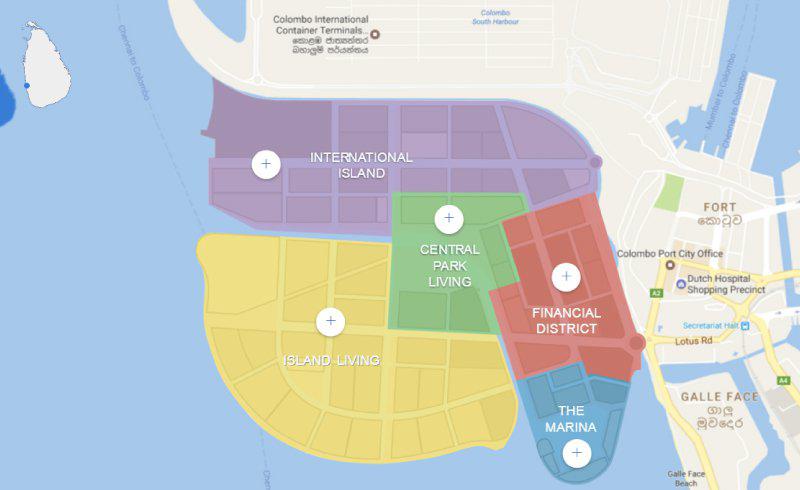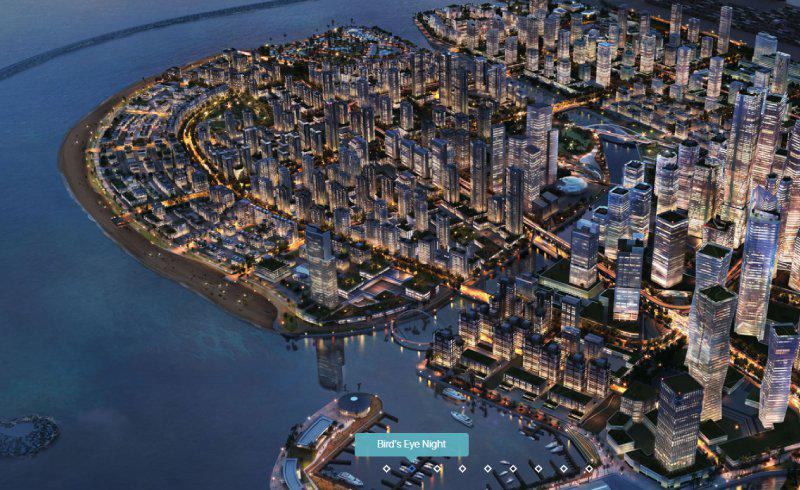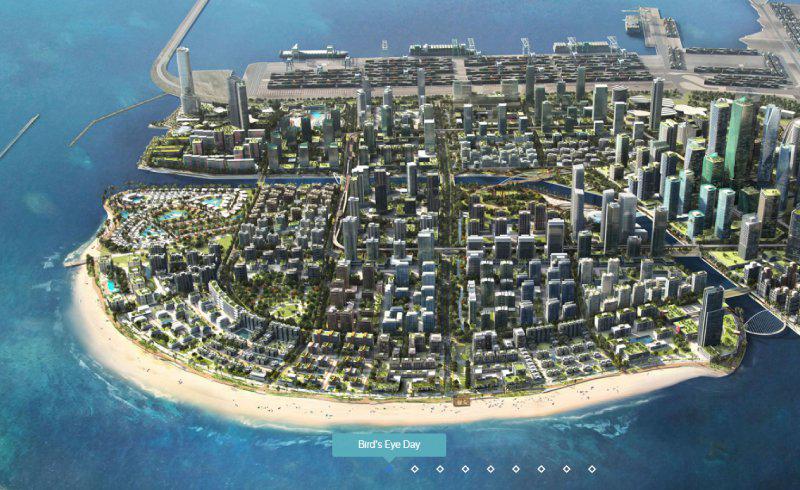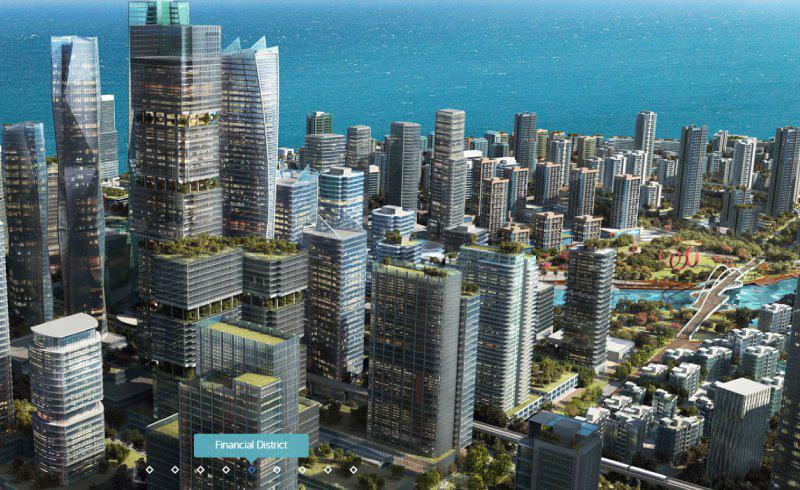Sri Lanka’s $US15 billion "Port City Colombo" Marked for Completion in 2041
Port City Colombo is a concept developed through the joint efforts of the Government of Sri Lanka and CHEC Port City Colombo's parent company China Communications Construction Company Limited (CCCC) – a Chinese multinational corporate. The project spans 269 hectares, and is estimated to be a $US15 billion investment upon completion in 2041.
Port City Colombo is a land reclamation project consisting of five different precincts: the Financial District, Central Park Living, Island Living, The Marina and the International Island.
Of the proposed 269 hectares to be reclaimed, 173 hectares is designated as "marketable land"; the master plan anticipates that the 173 hectare portion will be utilised to transform Port City Colombo into a hub for commerce, tourism, and culture in South Asia.
CHEC Port City Colombo announced last week that international design group Skidmore, Owings & Merrill LLP (SOM) won the International Urban Design Ideas Competition held for the Financial District and Marina District of Port City Colombo.
According to SOM their winning submission “offers a richness of urban opportunities and a robust framework with carefully designed public spaces.
“It presents a dynamic new vision for Colombo Port City that promises to deliver high quality urban environments for residents and visitors.
“The plan is designed to accommodate future growth and change within a sustainable development framework.”
SOM’s vision for Port City Colombo, selected as the unanimous winner by an international jury, was cited as demonstrating exceptional sensitivity to the ecological and cultural context of Sri Lanka.

Port City Colombo masterplan, image courtesy of CHEC
Origins of the Colombo Port City concept
Expansion of the Colombo Central Business District by land reclamation was originally proposed under the Government‐initiated Western Region Megapolis Regional Structure Plan in July 2004, prepared by Singapore-based urban planning consultants, CESMA International.
The original proposal prepared by CESMA initially intended to reclaim 221 hectares, of which 139.5 hectares was marketable land to meet Colombo CBD’s growing real estate needs. The revised proposal reclaims an additional 48 hectares, allowing for a further 97 hectares of marketable area, which is roughly the size of 90 football fields to be released for development at a rate of 7 hectares per annum.
China, South Korea, Japan, Singapore and the United Arab Emirates have all reclaimed land to capitalise on urbanisation. The first major land reclamation occurred in the Netherlands when the port of Rotterdam was extended with sand from the sea in the 1970s.
The Rotterdam development helped the port to become the largest in Europe. Subsequently, the “Maasvlakte II” project was carried out between 2008 and 2013, creating an additional 2000 hectares of land for further investments.

Artistic Impression - Port City Colombo night time birdseye, image courtesy of CHECDevelopment within Colombo Port City
Development within the 269 hectare reclaimed land area will be in keeping with the Government of Sri Lanka's strategic ambitions to:
Foster integrated oceanfront living within the CBD to provide a high quality of life through world‐class office, residential and recreational spaces that will attract tourists, professionals, entrepreneurs, managers and retirees
Position Colombo as the most liveable city in South Asia
To design and build a sustainable urban city space that adapts to local climate, creates a comfortable micro‐climate and make efficient use of energy resources.
No industrial development will be approved within the Port City. The following are examples of developments sanctioned for preliminary planning clearance provided under the master plan:
Commercial: Banks, offices and retail, hotels and restaurants, diplomatic embassies
Residential: Dwelling houses/units, apartment buildings, serviced apartments
Institutions: Healthcare, educational and R&D institutions
Entertainment: Indoor amusement and entertainment establishments, outdoor recreational spaces
Community: Art galleries, socio‐cultural establishments/community centres, tourism business, convention and event facilities

Artistic Impression - Port City Colombo day time birds eye view, image courtesy of CHECColombo Port City's Key Economic Benefits
As outlined by the Central Engineering Consultancy Bureau (CECB) in their 2015 Environmental Impact Assessment report – if executed successfully – Colombo will benefit from the following economic factors:
A foreign direct investment (FDI) of approximately US$1400 million, the largest private investment by any company in Sri Lanka, local or foreign, in a single project: FDIs has significant economic benefits to Sri Lanka’s balance of payments, technology transfer, local employment and value creation
Benefits of an investment by one of China’s largest companies, CCCC, and prospects of further investments by this company, related Group companies and other companies from the region.CCCC has already expressed an interest in building Sri Lanka’s largest office tower on reclaimed land in Port City upon completion of the required Phase 2 Environmental Impact Assessment, thus establishing the company as a long‐term investor in Sri Lanka
Value of land: The Colombo Port City is estimated to contain around 173 ha of marketable land. These will be leased/sold to third party developers in keeping with applicable laws and at market prices jointly decided by the GOSL and Project Company. The market value of the 173 ha of new marketable land, based on the 2015 average market price is estimated to be US$4.4 billion
Employment and Technology transfer: The Project Company employed over 1550 direct staff, almost all Sri Lankan, including 60 Sri Lankan professionals and engineers. The direct and indirect employment potential with the recommencement of construction would be around 6400 representing skilled, unskilled, technical and managerial categories
Creation of higher paying service sector jobs through new investments in buildings and infrastructure at Port City and the attraction of new businesses
Creation of public amenities such as parks, theme parks and other recreational facilities within Colombo’s CBD for all strata of society to enjoy.

Artistic Impression- Port City Colombo financial district, image courtesy of CHEC















